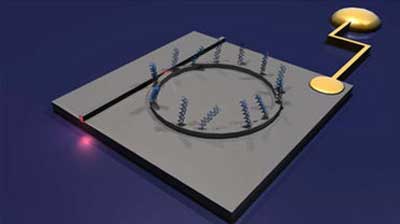| Posted: Sep 14, 2016 |
New sensor technology could speed up blood test analysis
(Nanowerk News) Researchers at the University of York have developed a new sensor that is capable of detecting multiple proteins and enzymes in a small volume of blood, which could significantly speed up diagnostic healthcare processes (Nature Communications, "The electro-photonic silicon biosensor").
|
|
Currently tests to detect the presence of infection or disease require a sample of blood from a patient, which is later analysed in a laboratory to detect markers of disease. The presence of particular proteins can give an indication of a health condition and the best course of treatment, but only one type of protein can be identified per sample.
|
|
If multiple tests are required, as is the case in the suspected presence of cancer cells or resistant infection, the delivery of results can take longer and the costs of testing increases.
|
|
The team at York, however, have developed a biosensor that combines light and electricity, to detect multiple disease biomarkers in one smaller sample of blood. The technology could make blood tests more comfortable for patients and enable results to be processed quicker.
|
 |
| 3D sketch of a single electro-optical device. Ohmic contacts fabricated on the doped silicon substrate allow electrochemical control over the sensor surface. (© Nature Publishing Group)
|
|
Professor Thomas Krauss, at the University of York’s Department of Physics, said: “These sensors can give fast, real time results and at low cost. The length of time and money that it takes laboratory technicians to identify just one protein in a patient sample is a real challenge for the NHS and can result in emotional distress for patients.
|
|
“Not only can this new technology speed the process up, but it can test for a number of proteins and enzymes together in just one sample, increasing the chances of a successful and timely diagnosis.”
|
|
Researchers are now looking to test the new technology in urine samples for urinary tract infections (UTIs), which has a high resistance to antibiotic treatment. If the biosensor can identify biomarkers of the infection and of resistance, it is more likely that the correct course of antibiotic treatment will be prescribed the first time around, rather than on repeat visits, which is often the case with UTIs.
|
|
Dr Steve Johnson, from the University of York’s Department of Electronics, said: “Combining light and electricity in silicon sensors has never been done before. This exciting new technology provides in-depth analysis of biological interactions and new ways of sensing on the micro-scale.”
|
|
The emergence of stratified and personalised medicines – the tailoring of treatments to the biology of the individual – has increased the demands on diagnostic technologies, particularly with healthcare challenges related to anti-microbial resistance.
|
|
PhD student, Jose Juan Colas, who conducted the research at the University’s Department of Physics, added: “This new diagnostic technique could have many applications and really pushes us forward in how we think about developing technologies for the future.
|
|
“By working together across multiple disciplines we have demonstrated a unique technology with the potential to make a real difference to health science, clinical practice, and basic science.”
|

